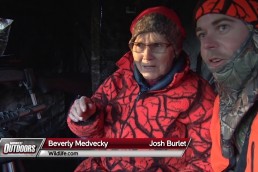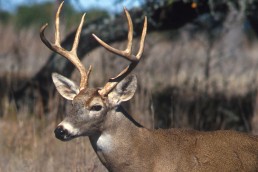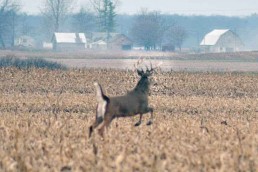River Bottom Deer Drives are Effective
SHARE THIS POST
River bottoms hold whitetails, especially in agricultural lands. Once the crops come down, whitetails flock to the cover of river bottoms during daylight hours to bed and browse. There might not be a more effective way for a couple of hunters to tag a buck during daylight hours than conducting a two-man river bottom deer drive.
River bottoms are typically long, narrow strips of cover, sandwiched between wide-open space and water. These woodland or brushy strips serve as key bedding areas. When deer are bumped or pushed in a river bottom, they’ll usually try to remain within the cover, to avoid exposing themselves by running across open ground or swimming the river. This makes river bottoms especially productive locations for pushing deer in the direction you want them to move.
An ideal location is a relatively rectangular strip of cover no more than a couple of hundred yards wide, with a river on one side too large for deer to easily cross, and a large expanse of open space, like a picked agricultural field or large pasture, on the other. It really doesn’t matter how long the strip of cover is, because you can break it up into manageable sections. You can start the driver at any point, and he’ll push the woods towards the stander.
Since you expect the deer to stay in the cover, river bottom drives are one of the more effective ways for bowhunters to conduct a deer drive. To up the odds of pushing deer within bow range, select strips of cover to drive that are relatively narrow. With adequate shooting lanes, a bowhunter on stand should be able to cover a strip of timber 100 yards wide.
To set up for the drive, first drop your stander off where they intend to stay on stand. Then the driver goes back to where he plans to begin the push. Once the driver reaches the stander, assuming the drive didn’t produce, you can repeat the process. This also makes it simple for switching up drivers and standers.
Are you enjoying this post?
You can be among the first to get the latest info on where to go, what to use and how to use it!
During the drive, you want the wind at the back of the driver. Ideally, the scent of the driver will push the deer towards the stander, without ever actually seeing the driver. You don’t want to spook the deer into a panic that causes a full-speed run. You want the deer moving slowly when they reach the stander.
The driver should slowly, but steadily move through the cover towards the stander. Avoid walking in a straight line, and stay of well-worn trails. Deer don’t bed right next to the most heavily used trails. They’ll be in the thick briar tangles, next to large blown-down trees and on top of any little rise that gives them a better view. Just proceed with a nice slow, steady zigzag pattern through the cover, making sure to stop and stand still every few minutes. While you’re moving, many deer will hold tight to cover, hoping you pass right on by without noticing them. But their nerves will likely get the best of them if you stop. That’s when they’ll bolt.
Since most river bottoms are typically flat, and the deer will be coming toward the stander from the direction of the driver, it is of the utmost importance that no firearms are fired back toward the driver. The stander must wait for the deer to clear them, or be beyond them, before shooting.
Using portable treestands to elevate the stander affords a greater view, allowing the stander to see more deer. Use portable stands that set up and come down quickly. Climbing stands often work well in river bottoms where oaks, cottonwoods and other trees with few low limbs are found.
Hanging out at camp or taking a nap during mid-day might be nice. But if you really want to punch your tag, a river bottom deer drive is a productive way to take a midday buck.
MWO
SHARE THIS POST
Did you enjoy this post?
You can be among the first to get the latest info on where to go, what to use and how to use it!
Brandon Butler
As past executive director of the Conservation Federation of Missouri, Brandon Butler has made a name for himself by fighting to protect fish and wildlife, and critical habitats. His syndicated column, “Driftwood Outdoors,” appears in more than 30 newspapers, weekly, across Missouri and Indiana. Reach him via email at bbutler@driftwoodoutdoors.com.



